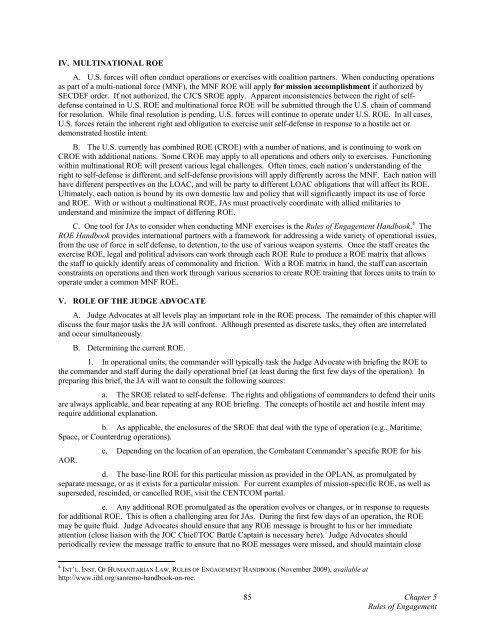The Law of War
The Law of War
The Law of War
Create successful ePaper yourself
Turn your PDF publications into a flip-book with our unique Google optimized e-Paper software.
IV. MULTINATIONAL ROE<br />
A. U.S. forces will <strong>of</strong>ten conduct operations or exercises with coalition partners. When conducting operations<br />
as part <strong>of</strong> a multi-national force (MNF), the MNF ROE will apply for mission accomplishment if authorized by<br />
SECDEF order. If not authorized, the CJCS SROE apply. Apparent inconsistencies between the right <strong>of</strong> selfdefense<br />
contained in U.S. ROE and multinational force ROE will be submitted through the U.S. chain <strong>of</strong> command<br />
for resolution. While final resolution is pending, U.S. forces will continue to operate under U.S. ROE. In all cases,<br />
U.S. forces retain the inherent right and obligation to exercise unit self-defense in response to a hostile act or<br />
demonstrated hostile intent.<br />
B. <strong>The</strong> U.S. currently has combined ROE (CROE) with a number <strong>of</strong> nations, and is continuing to work on<br />
CROE with additional nations. Some CROE may apply to all operations and others only to exercises. Functioning<br />
within multinational ROE will present various legal challenges. Often times, each nation’s understanding <strong>of</strong> the<br />
right to self-defense is different, and self-defense provisions will apply differently across the MNF. Each nation will<br />
have different perspectives on the LOAC, and will be party to different LOAC obligations that will affect its ROE.<br />
Ultimately, each nation is bound by its own domestic law and policy that will significantly impact its use <strong>of</strong> force<br />
and ROE. With or without a multinational ROE, JAs must proactively coordinate with allied militaries to<br />
understand and minimize the impact <strong>of</strong> differing ROE.<br />
C. One tool for JAs to consider when conducting MNF exercises is the Rules <strong>of</strong> Engagement Handbook. 4 <strong>The</strong><br />
ROE Handbook provides international partners with a framework for addressing a wide variety <strong>of</strong> operational issues,<br />
from the use <strong>of</strong> force in self defense, to detention, to the use <strong>of</strong> various weapon systems. Once the staff creates the<br />
exercise ROE, legal and political advisors can work through each ROE Rule to produce a ROE matrix that allows<br />
the staff to quickly identify areas <strong>of</strong> commonality and friction. With a ROE matrix in hand, the staff can ascertain<br />
constraints on operations and then work through various scenarios to create ROE training that forces units to train to<br />
operate under a common MNF ROE.<br />
V. ROLE OF THE JUDGE ADVOCATE<br />
A. Judge Advocates at all levels play an important role in the ROE process. <strong>The</strong> remainder <strong>of</strong> this chapter will<br />
discuss the four major tasks the JA will confront. Although presented as discrete tasks, they <strong>of</strong>ten are interrelated<br />
and occur simultaneously.<br />
B. Determining the current ROE.<br />
1. In operational units, the commander will typically task the Judge Advocate with briefing the ROE to<br />
the commander and staff during the daily operational brief (at least during the first few days <strong>of</strong> the operation). In<br />
preparing this brief, the JA will want to consult the following sources:<br />
a. <strong>The</strong> SROE related to self-defense. <strong>The</strong> rights and obligations <strong>of</strong> commanders to defend their units<br />
are always applicable, and bear repeating at any ROE briefing. <strong>The</strong> concepts <strong>of</strong> hostile act and hostile intent may<br />
require additional explanation.<br />
b. As applicable, the enclosures <strong>of</strong> the SROE that deal with the type <strong>of</strong> operation (e.g., Maritime,<br />
Space, or Counterdrug operations).<br />
AOR.<br />
c. Depending on the location <strong>of</strong> an operation, the Combatant Commander’s specific ROE for his<br />
d. <strong>The</strong> base-line ROE for this particular mission as provided in the OPLAN, as promulgated by<br />
separate message, or as it exists for a particular mission. For current examples <strong>of</strong> mission-specific ROE, as well as<br />
superseded, rescinded, or cancelled ROE, visit the CENTCOM portal.<br />
e. Any additional ROE promulgated as the operation evolves or changes, or in response to requests<br />
for additional ROE. This is <strong>of</strong>ten a challenging area for JAs. During the first few days <strong>of</strong> an operation, the ROE<br />
may be quite fluid. Judge Advocates should ensure that any ROE message is brought to his or her immediate<br />
attention (close liaison with the JOC Chief/TOC Battle Captain is necessary here). Judge Advocates should<br />
periodically review the message traffic to ensure that no ROE messages were missed, and should maintain close<br />
4 INT’L. INST. OF HUMANITARIAN LAW, RULES OF ENGAGEMENT HANDBOOK (November 2009), available at<br />
http://www.iihl.org/sanremo-handbook-on-roe.<br />
85 Chapter 5<br />
Rules <strong>of</strong> Engagement

















